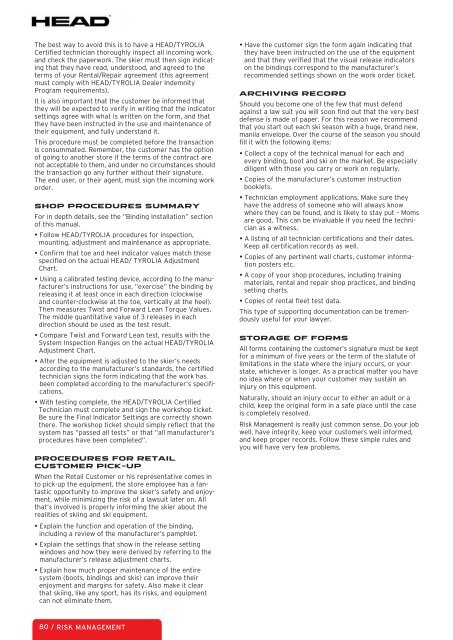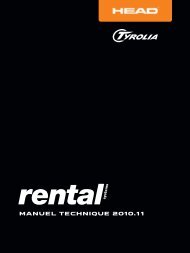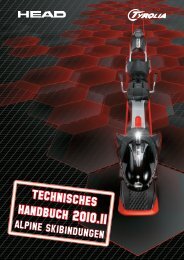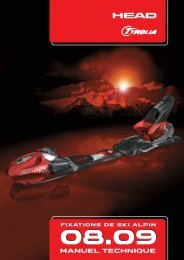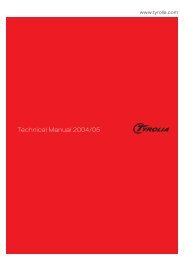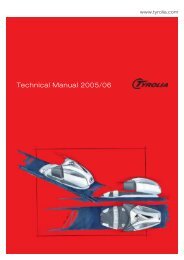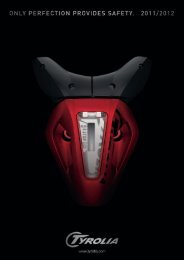You also want an ePaper? Increase the reach of your titles
YUMPU automatically turns print PDFs into web optimized ePapers that Google loves.
The best way to avoid this is to have a HEAD/TYROLIA<br />
Certified technician thoroughly inspect all incoming work,<br />
and check the paperwork. The skier must then sign indicating<br />
that they have read, understood, and agreed to the<br />
terms of your Rental/Repair agreement (this agreement<br />
must comply with HEAD/TYROLIA Dealer Indemnity<br />
Program requirements).<br />
It is also important that the customer be informed that<br />
they will be expected to verify in writing that the indicator<br />
settings agree with what is written on the form, and that<br />
they have been instructed in the use and maintenance of<br />
their equipment, and fully understand it.<br />
This procedure must be completed before the transaction<br />
is consummated. Remember, the customer has the option<br />
of going to another store if the terms of the contract are<br />
not acceptable to them, and under no circumstances should<br />
the transaction go any further without their signature.<br />
The end user, or their agent, must sign the incoming work<br />
order.<br />
SHOP PROCEDURES SUMMARY<br />
For in depth details, see the “Binding Installation” section<br />
of this manual.<br />
• Follow HEAD/TYROLIA procedures for inspection,<br />
mounting, adjustment and maintenance as appropriate.<br />
• Confirm that toe and heel indicator values match those<br />
specified on the actual HEAD/ TYROLIA Adjustment<br />
Chart.<br />
• Using a calibrated testing device, according to the manufacturer’s<br />
instructions for use, “exercise” the binding by<br />
releasing it at least once in each direction (clockwise<br />
and counter-clockwise at the toe, vertically at the heel).<br />
Then measures Twist and Forward Lean Torque Values.<br />
The middle quantitative value of 3 releases in each<br />
direction should be used as the test result.<br />
• Compare Twist and Forward Lean test, results with the<br />
System Inspection Ranges on the actual HEAD/TYROLIA<br />
Adjustment Chart.<br />
• After the equipment is adjusted to the skier’s needs<br />
according to the manufacturer’s standards, the certified<br />
technician signs the form indicating that the work has<br />
been completed according to the manufacturer’s specifications.<br />
• With testing complete, the HEAD/TYROLIA Certified<br />
Technician must complete and sign the workshop ticket.<br />
Be sure the Final Indicator Settings are correctly shown<br />
there. The workshop ticket should simply reflect that the<br />
system has “passed all tests” or that “all manufacturer’s<br />
procedures have been completed”.<br />
PROCEDURES FOR RETAIL<br />
CUSTOMER PICK-UP<br />
When the Retail Customer or his representative comes in<br />
to pick-up the equipment, the store employee has a fantastic<br />
opportunity to improve the skier’s safety and enjoyment,<br />
while minimizing the risk of a lawsuit later on. All<br />
that’s involved is properly informing the skier about the<br />
realities of skiing and ski equipment.<br />
• Explain the function and operation of the binding,<br />
including a review of the manufacturer’s pamphlet.<br />
• Explain the settings that show in the release setting<br />
windows and how they were derived by referring to the<br />
manufacturer’s release adjustment charts.<br />
• Explain how much proper maintenance of the entire<br />
system (boots, bindings and skis) can improve their<br />
enjoyment and margins for safety. Also make it clear<br />
that skiing, like any sport, has its risks, and equipment<br />
can not eliminate them.<br />
80 / RISK MANAGEMENT<br />
• Have the customer sign the form again indicating that<br />
they have been instructed on the use of the equipment<br />
and that they verified that the visual release indicators<br />
on the bindings correspond to the manufacturer’s<br />
recommended settings shown on the work order ticket.<br />
ARCHIVING RECORD<br />
Should you become one of the few that must defend<br />
against a law suit you will soon find out that the very best<br />
defense is made of paper. For this reason we recommend<br />
that you start out each ski season with a huge, brand new,<br />
manila envelope. Over the course of the season you should<br />
fill it with the following items:<br />
• Collect a copy of the technical manual for each and<br />
every binding, boot and ski on the market. Be especially<br />
diligent with those you carry or work on regularly.<br />
• Copies of the manufacturer’s customer instruction<br />
booklets.<br />
• Technician employment applications. Make sure they<br />
have the address of someone who will always know<br />
where they can be found, and is likely to stay put – Moms<br />
are good. This can be invaluable if you need the technician<br />
as a witness.<br />
• A listing of all technician certifications and their dates.<br />
Keep all certification records as well.<br />
• Copies of any pertinent wall charts, customer information<br />
posters etc.<br />
• A copy of your shop procedures, including training<br />
materials, rental and repair shop practices, and binding<br />
setting charts.<br />
• Copies of rental fleet test data.<br />
This type of supporting documentation can be tremendously<br />
useful for your lawyer.<br />
STORAGE OF FORMS<br />
All forms containing the customer’s signature must be kept<br />
for a minimum of five years or the term of the statute of<br />
limitations in the state where the injury occurs, or your<br />
state, whichever is longer. As a practical matter you have<br />
no idea where or when your customer may sustain an<br />
injury on this equipment.<br />
Naturally, should an injury occur to either an adult or a<br />
child, keep the original form in a safe place until the case<br />
is completely resolved.<br />
Risk Management is really just common sense. Do your job<br />
well, have integrity, keep your customers well informed,<br />
and keep proper records. Follow these simple rules and<br />
you will have very few problems.


